S.E. Lindberg's Blog, page 59
July 6, 2013
Moments of Truth - Book Publishing
Delighting Readers - Even During the First Moment of Truth
 Packaging design to delight Goodreads.com Giveaway Winners.
Packaging design to delight Goodreads.com Giveaway Winners.
Moments of Truth - Consumer ProductsProcter & Gamble coined the key instances in which a customer becomes impressed with a product as "Moments of Truth." Historically, the First Moment of Truth (FMOT) refered to when the customer saw a package on a store shelf; this experience influenced not only the possible purchase...but it set up expectations for the quality of the product. The Second Moment (SMOT) was the instance when the product was used, and the customer assessed whether or not the experience matched expectations. With the internet changing customer habits, another instance was eventually coined: the Zero Moment of Truth (ZMOT, Link), which is when customers form expectations before directly contacting (touching) the product!

Moments of Truth - BooksHow does this framework translate to today's book selling? In this case, the ZMOT occurs when readers comb through online reader/customer reviews. Given that fewer and fewer books are purchased in an actual bookstore, the FMOT will likely be when a book arrives by mail (though one may argue it is when the cover is seen...online...or on an electronic device). The SMOT is when the reader actually reads the book. The main premise is to identify all touchpoints between the consumer and the product, and then enlighten each instance.
Can the packaging effect the overall experience? Yes. The care exhibited in packaging reflects the care imparted when making the product. One winner even wrote back a hand-written note acknowledging the tradecraft:
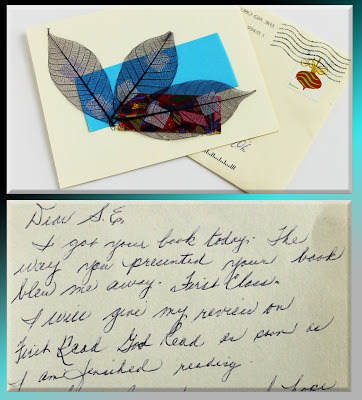
 Packaging design to delight Goodreads.com Giveaway Winners.
Packaging design to delight Goodreads.com Giveaway Winners.
Moments of Truth - Consumer ProductsProcter & Gamble coined the key instances in which a customer becomes impressed with a product as "Moments of Truth." Historically, the First Moment of Truth (FMOT) refered to when the customer saw a package on a store shelf; this experience influenced not only the possible purchase...but it set up expectations for the quality of the product. The Second Moment (SMOT) was the instance when the product was used, and the customer assessed whether or not the experience matched expectations. With the internet changing customer habits, another instance was eventually coined: the Zero Moment of Truth (ZMOT, Link), which is when customers form expectations before directly contacting (touching) the product!


Moments of Truth - BooksHow does this framework translate to today's book selling? In this case, the ZMOT occurs when readers comb through online reader/customer reviews. Given that fewer and fewer books are purchased in an actual bookstore, the FMOT will likely be when a book arrives by mail (though one may argue it is when the cover is seen...online...or on an electronic device). The SMOT is when the reader actually reads the book. The main premise is to identify all touchpoints between the consumer and the product, and then enlighten each instance.
"Every touchpoint with a reader is important..."The end of one reader's experience will start the process for a subsequent one, but less than ~10% of readers will post reviews (a statistic based on my own experience). This amplifies the need to impress potential readers whenever possible. "Giveaways" are an efficient way to jumpstart the process; these are online-events in which readers signup for complimentary copies of the book...usually with a non-binding commitment to review it. Every several months I host Giveaways of hardcopy (via Goodreads.com) and electronic books (via LibrayThing.com) for Lords of Dyscrasia. Every touchpoint with a customer is important, and a crafty partner of mine reminded me early on to not overlook one. With the focus on on-line/virtual touchpoints, I almost neglected to make the FMOT delightful for those receiving hardcopies by snail mail. Thanks to her, the books awarded to Giveaway winners have always been wrapped to impress (thanks Designlab!). The packaging features a handwritten note with well-folded Kraft paper; a presentation to enhance the First Moment of Truth for Lords of Dyscrasia readers.
Can the packaging effect the overall experience? Yes. The care exhibited in packaging reflects the care imparted when making the product. One winner even wrote back a hand-written note acknowledging the tradecraft:
"Dear S.E., I got your book today. The way you presented your book blew me away. First Class. I will give my review on First Read Good Reads as soon as I am finished reading. Good luck to you. I hope you sell a million. Sincerely, [reader]"

Published on July 06, 2013 22:00
June 30, 2013
July Aug 2013 - Groupread: Jack Vance and Your-Own-To-Read-Pile

Time to address "The Dying Earth" and Your-Own-To-Read pile!
Like to read? Like fantasy fiction? Feel welcome to join the Sword & Sorcery group on Goodreads. This Summer we have to parallel Groupreads (for July-August 2013):
1) Jack Vance: With the recent passing of Jack Vance , we’ll reflect on his work this Summer (July-August): Link to Jack Vance Groupread. An ideal time to read/discuss The Dying Earth series.
2) To-Read Pile: A second group read with the theme of “Anything in your own To-Read pile.” The perfect excuse to read your ever-growing To-Read pile. Choose a Sword & Sorcery book from there, then confess why you haven't read it sooner here: Link to To-Read Groupread!
Masthead: As always, the masthead banner image for the group reflects these.
The Dying Earth, The Eyes of the Overworld, Cugel's Saga, Rhialto The Marvellous
Montage created from these covers, credits go to artist (L to R)
Unknown ,1950; Jack Gaughan, 1966; Kevin Johnson, 1983; Stephen E. Fabian, 1984




Published on June 30, 2013 22:00
June 15, 2013
The Resurrectionist: The Lost Work of Dr. Spencer Black - Review by S.E.Lindberg
 The Resurrectionist: The Lost Work of Dr. Spencer Black by E.B. Hudspeth
The Resurrectionist: The Lost Work of Dr. Spencer Black by E.B. HudspethS.E. Lindberg rating: 5 of 5 stars
Hybrid Art Forms in Man: At what point does “man” begin and “animal” end?The Resurrectionist: The Lost Work of Dr. Spencer Black opens with a dense, interesting narrative: the biography of the dark protagonist. Readers tend to get bored with extended narratives, so this introduction is appropriately short. It is a compelling setup, of course, for the illustrations (the latter 2/3rds of book). The author sets the horrific tenor here, enticing the reader to share the excitement that Spencer feels for defining the human condition. Only sensitive readers will cringe at the horror since author E.B. Hudspeth is tactful in his delivery of the macabre. He, like his character Spencer, merely wants to set the readers “free.” True to the role of speculative fiction, he presents art that appears real…then lets the reader ponder the boundary between fact/fiction. The below quote from Spencer seems to echo Hudspeth’s motivation:
"I hear them marvel at my work—my indignant science. I hear them call out in fear of what they see. And there are some gentlemen who doubt what I will tell them. They call me a liar and a charlatan or a quack. But in time the methods of science that I now employ to convince people will surely set them free—alas, this I cannot explain to the angry fools."The setting is ideal for redefining the nature of “man.” The turn of the 19th century was rich with advances in evolutionary theory, science, and even speculative fiction. Anatomists, philosophers, and scientists ruminated on how far to extrapolate Darwin’s assertions. Most understood that all vertebrates shared a common skeletal structure; but if animals and man were connected in their development, was it not reasonable to reconsider the existence of creatures termed mythological? Where centaurs real? Harpies? Demons? Spencer Black needed to know. Hudspeth uses him to lure us on this quest.
[image error]
There are real life analogues to the fictitious Spencer. Ernst Haeckel (1834–1919) comes to mind. A dedicated, philosophical scientist with outstanding artistic skills, he documented thousands of life forms and published his beautiful plates in “Art Forms in Nature” (translated from German: Kunstforman der Natur). But then his fascination with Art-Nature caused an uproar when he tweaked his drawings of embryos in 1874. Haeckel envisioned familiarities across the embryos of fish, salamanders, turtles, pigs, rabbits, and humans; then he represented these in an evocative table. At a time when photography was not practiced, data was art…and vice versa. Some still claim his drawings were legitimate, but in any case, his artistic embellishments stirred a controversy. That controversy is the same the Hudspeth delivers:
At what point does “man” begin and “animal” end?
The fictional Spencer Black is more corrupt than the real Ernest Haeckel, but now their books share space on my bookshelf. I recommend the hardcopy so you can use it as coffee table book. The anatomical drawings of mythological creatures will certainly entertain and inspire. Preview his artwork at his website: http://ebhudspeth.com/blog/artwork/ .
[image error]
View all my reviews
Published on June 15, 2013 06:44
June 11, 2013
A Slimy Trope: Sewer Entrances in Sword & Sorcery Movies
When did invading a fortress via a sewer become popular? I do not know precisely, but there has been a recent surge. Between late 2011 and mid-2012, I saw three Sword & Sorcery movies that employed this tactic (details below). Two of these involved the protagonists breaking-in to their infested homes. I think the originality has been exhausted now, and I hope this fad fades away.
Star Wars IV: A New Hope 1977Death Star Fortress- Sewer Exit-EscapeGeorge Lucas deserves credit for cinematically popularizing a fortress escape sewer-scene in his 1977 Star Wars IV, A New Hope (Death Star garbage compactor scene). Ostensibly, Star Wars is Sci-Fi rather than Fantasy, but it employs most every Fantasy trope that exits. It certainly seems to have inspired the 2011 Conan the Barbarian break-in into Zym's tower (below).
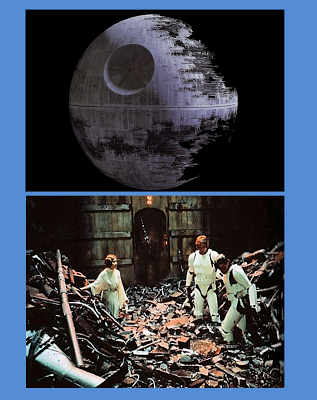 Conan the Barbarian - 2011Khalar Zym’s Skull Tower: Sewer EntranceMore special effects were dedicated to the randomly-placed, lurking sewer-serpent than were used to demonstrate the power of the magical mask motivating the story. So strangely, this scene was more exciting than the climax of the movie (Here is a link to my rant on that).
Conan the Barbarian - 2011Khalar Zym’s Skull Tower: Sewer EntranceMore special effects were dedicated to the randomly-placed, lurking sewer-serpent than were used to demonstrate the power of the magical mask motivating the story. So strangely, this scene was more exciting than the climax of the movie (Here is a link to my rant on that).
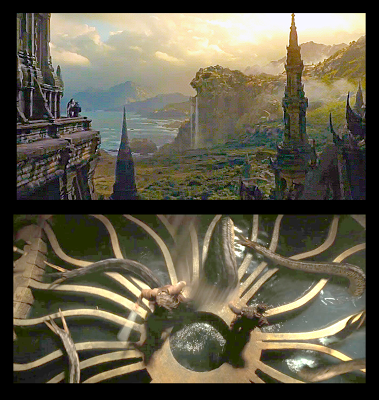
Solomon Kane – 2009 globally (2012 in USA via Video Streaming)Josiah Kane’s Castle: Drainage EntranceI enjoyed this movie (Link to review) , but I took a sigh when this sewer-trope was demonstrated.
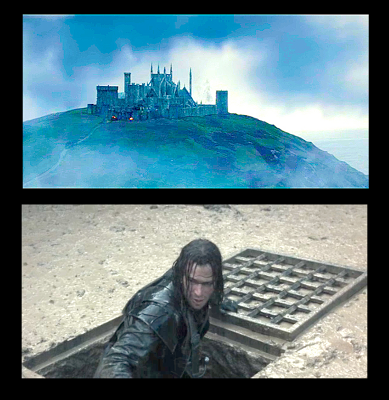 Snow White and the Huntsman 2012Ravenna’s (and Snow White’s) Castle; Sewer EntranceSnowwhite had escaped the castle via the drainage tunnels, so when she returns with and army, she sends some dwarves in to raise the gate. Very clever...I suppose.
Snow White and the Huntsman 2012Ravenna’s (and Snow White’s) Castle; Sewer EntranceSnowwhite had escaped the castle via the drainage tunnels, so when she returns with and army, she sends some dwarves in to raise the gate. Very clever...I suppose.
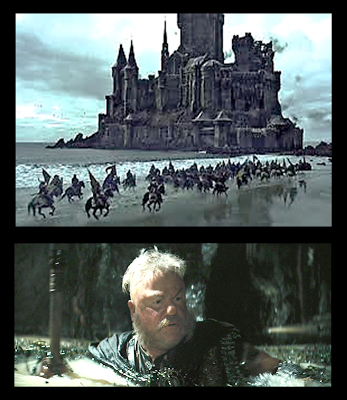
Star Wars IV: A New Hope 1977Death Star Fortress- Sewer Exit-EscapeGeorge Lucas deserves credit for cinematically popularizing a fortress escape sewer-scene in his 1977 Star Wars IV, A New Hope (Death Star garbage compactor scene). Ostensibly, Star Wars is Sci-Fi rather than Fantasy, but it employs most every Fantasy trope that exits. It certainly seems to have inspired the 2011 Conan the Barbarian break-in into Zym's tower (below).
 Conan the Barbarian - 2011Khalar Zym’s Skull Tower: Sewer EntranceMore special effects were dedicated to the randomly-placed, lurking sewer-serpent than were used to demonstrate the power of the magical mask motivating the story. So strangely, this scene was more exciting than the climax of the movie (Here is a link to my rant on that).
Conan the Barbarian - 2011Khalar Zym’s Skull Tower: Sewer EntranceMore special effects were dedicated to the randomly-placed, lurking sewer-serpent than were used to demonstrate the power of the magical mask motivating the story. So strangely, this scene was more exciting than the climax of the movie (Here is a link to my rant on that).
Solomon Kane – 2009 globally (2012 in USA via Video Streaming)Josiah Kane’s Castle: Drainage EntranceI enjoyed this movie (Link to review) , but I took a sigh when this sewer-trope was demonstrated.
 Snow White and the Huntsman 2012Ravenna’s (and Snow White’s) Castle; Sewer EntranceSnowwhite had escaped the castle via the drainage tunnels, so when she returns with and army, she sends some dwarves in to raise the gate. Very clever...I suppose.
Snow White and the Huntsman 2012Ravenna’s (and Snow White’s) Castle; Sewer EntranceSnowwhite had escaped the castle via the drainage tunnels, so when she returns with and army, she sends some dwarves in to raise the gate. Very clever...I suppose.
Published on June 11, 2013 08:49
June 1, 2013
Leiber’s Mouser and Fafhrd are the Scooby and Shaggy Of Sword and Sorcery
 Swords Against Death by Fritz Leiber
Swords Against Death by Fritz LeiberS.E.Lindberg's rating: 4 of 5 stars
Leiber’s Mouser and Fafhrd are the Scooby and Shaggy Of Sword and Sorcery
Atmosphere and Style: Fafhrd and Mouser are two rogues who are braver and smarter than Scooby and Shaggy, but form as legendary a duo in many ways. The pair were chronicled over ~5 decades by the man who termed the genre “Sword & Sorcery” (Fritz Leiber) in separate short stories (covering ~40 stories, published over 1939 to 1991). Their adventures in the City of Lankhmar and World of Nehwon were captured in seven books. Scooby Doo Where Are You was a Hanna-Barbera production, broadcast from 1969 to 1978 (notably the same time many of Leiber’s work was compiled into novels.)
Scooby Doo (and its reboots) were/are known for juxtaposing scary atmospheres with acceptable silliness…in episodic form. This is exactly what Swords against Death delivers, and presumably represents the other Fafred and Mouser tales. A possible exception is the chapter “Ill met in Lankhmar” (the last story in Vol-1 “Swords and Deviltry” in which the scary-silly style is presented, but the outcome more dire than anything in this second volume.
Fafhrd and the Mouser float from one independent adventure to the next. Each chapter is an enjoyable episode, but there is an apparent lack of an overarching conflict for the duo. Ostensibly the chapters are linear in chronology, but they really seemed stand alone and could be read in any order. From the opening (and the end of the first Volume Swords and Deviltry) I expected the pair to be haunted by their past loves, but these haunts only addressed in only one chapter later.
Varied perspectives and controlled revelations keep each narrative fresh. The stories are indeed fortified with literate prose and abundant vocabulary, but just when you think Leiber may take his milieu too seriously, you will be treated to a ludicrous robbery by fishing pole, a grand displacement/theft of a house, an assault from giant snowballs, or a hunt from bad guys skiing in an apparent satire to a Bond film. But, the silliness does not detract from enjoyable adventure. Just like the original Scooby Doo cartoon.
Emotive Oil Painting: Oil paintings will forever inspire emotion of fantasy media. For Scooby Doo, background stylist Walt Peregoy created some truly scary paintings worthy as any cover art. During the same years, Jeff Jones illustrated most (all?) of the ~1970's editions for Fritz Leiber (below list). Check them out:
1970; 1970; 1968; 1968; 1968;1977; 1988







View all my reviews
Published on June 01, 2013 09:24
May 26, 2013
Bookend Chronicles: Lords Of Dyscrasia review
Bookend Chronicles consistently weaves thoughtful context with excerpts to provide helpful reviews. It just posted its comprehensive review of Bookend Chronicles: Lords Of Dyscrasia (Link). I copy/paste the text below since it should help potential readers decide if they want to tour the Underworld:
For years, the movie industry has inundated us with some of the most graphic, disturbing, horror-laden tales of terror on the silver screen. It would be quite a rare occasion for a story to cause a deep stir in a desensitized mind. But once in a while, a story is constructed that motivates the mind and gets the wheels once again turning in anticipation.
Such is the Lords Of Dyscrasia by S.E. Lindberg.
Lindberg depicts an intensely savage and volatile world within the pages of Dyscrasia. It is a persistent plague that invades the blood and changes the human genome forever. Doctor Grave desperately seeks to save the long bloodline of his sick queen.
"The lifeless embryos exhibit the disease explicitly. The stillborn mutants present eldritch traits, all unique and terrible. Beaks and downy feathers adorn the avian ones. Translucent, soft-shell exoskeletons wrap the invertebrate insectan type, which are always infected with worms."
The disease has sunken into every crevice of daily life. It is no longer an aberrant anomaly, it has become an accepted form of life. Yet there is an unspoken hope that still exists.
"Anyone who could conquer this disease, which is rooted in the fabric of the Land, must be likewise terrible. Perhaps there will be a hero, a warrior who will vanquish dyscrasia, only to usher unforeseen horrors into this world—horrors that will make us all suffer so much we will wish dyscrasia to return…"
Endenken, the leader of a dying culture, wrestles with his own personal demons. Expected to abide by the traditional rules of his people, he must make difficult decisions in a world strife with the disease. His decision will mark the beginning of an end.
"Their blood was sacred. They had few left to carry it. And it was Endenken’s turn to inherit the burden... And the masked grotesqueries swarmed him now, their human frames transfigured by ornate markings and hollow eldritch skeletons."
The gruesome tale continues and illuminates the struggle within the bonds of humanity. An edict of the soul resounds throughout the pages of this nightmarish other-world with spots of dark humor. Lindberg has created an alternate reality that forces the reader to expand the limitations of their imagination.
We must further open our own minds and perhaps even edify our own traditional definitions of religion, belief, and faith.
The illustrations contained are morbid works of art, continuing to tell an epic that is both compelling and fascinating. Even the cover provides a sense of expectancy.
S.E. Lindberg lives near Cincinnati, Ohio. He works as a microscopist, and has spent two decades practicing chemistry.
Published on May 26, 2013 14:45
May 4, 2013
Sword and Sorcery Movie Trends - Quantity and Quality
Movie Queue: The last few years I have been capturing lists of forthcoming Sword & Sorcery movies (Link to 2013 S&S Movie Queue). Moving beyond that, in an attempt to capture a list of past Sword and Sorcery movies, I assembled a Pinterest Board.
This exercise made me realize that I had missed seeing Roger Corman's 1980's Cult Classics movies: DeathStalker I,II,II, IV, and the Barbarian Queen, and the Warrior and the Sorceress. Amazon has a collection deal, in which I can get 4 of those. Would it be worth my time/money (6hrs/$18USD) to complete this gaping hole in my life? How essential are these B-movies toward developing a well-rounded S&S groupie? I have since ordered the movies...and will be watching them soon...more on that below.
Therapy: I had turned to the Sword and Sorcery group on Goodreads for some biased advice. There author Bruce Durham directed me toward a great website that details what elements Sword & Sorcery movies are expected to have, and has a great list of movies listed by release date. To see the trends over time I graphed a histogram:
Quantity - Movies per Year
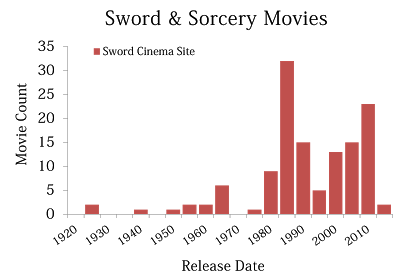 QualityTrends: The trends show clearly how the 1982 John Milius's "Conan The Barbarian" movie, starring Arnold Schwarzenegger, inspired a lot of others. Some featured new perspectives, like Excalibur, Fire and Ice, and Legend...and were good enough not dilute the genre. Unfortunately many "Conan clones" generally lacked in quality. Well actually, even Arnold's Conan the Destroyer was not so great...nor was the 2011 Conan reboot with Jason Momoa (which had a blatant disregard for following through on basic story-telling).
QualityTrends: The trends show clearly how the 1982 John Milius's "Conan The Barbarian" movie, starring Arnold Schwarzenegger, inspired a lot of others. Some featured new perspectives, like Excalibur, Fire and Ice, and Legend...and were good enough not dilute the genre. Unfortunately many "Conan clones" generally lacked in quality. Well actually, even Arnold's Conan the Destroyer was not so great...nor was the 2011 Conan reboot with Jason Momoa (which had a blatant disregard for following through on basic story-telling).
Future of Hope: Peter Jackson's excellent treatment of Tolkien's Lord of the Rings in 2001 seems to have sparked another surge. Fans should be hopeful. With the excellent translation of George Martins Game of Thrones on HBO (being a series and not a movie, that is not captured in the graph), Peter Jackson's Hobbit trilogy in progress, a live action version of Fire and Ice in the works, and even a sequel to Solomon Kane brewing...we have reason to beleive that the portfolio of Sword & Sorcery movies will grow in quantity and quality. In fact Dealine.com reports that "Legend of Conan ~2014" intends to redeem Conan's credibility:
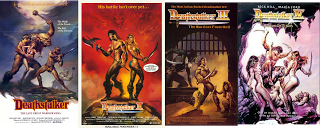 Boris Vallejo covers for the Deathstalker Series
Boris Vallejo covers for the Deathstalker Series
CineMassacre
Uncensored version link here (Click)
Posted on: March 12, 2010 | Views: 4,509 | CommentJames Rolfe enters a twisted, chaotic world of darkness from legendary schlockmeister Roger Corman.
This exercise made me realize that I had missed seeing Roger Corman's 1980's Cult Classics movies: DeathStalker I,II,II, IV, and the Barbarian Queen, and the Warrior and the Sorceress. Amazon has a collection deal, in which I can get 4 of those. Would it be worth my time/money (6hrs/$18USD) to complete this gaping hole in my life? How essential are these B-movies toward developing a well-rounded S&S groupie? I have since ordered the movies...and will be watching them soon...more on that below.
Therapy: I had turned to the Sword and Sorcery group on Goodreads for some biased advice. There author Bruce Durham directed me toward a great website that details what elements Sword & Sorcery movies are expected to have, and has a great list of movies listed by release date. To see the trends over time I graphed a histogram:
Quantity - Movies per Year
 QualityTrends: The trends show clearly how the 1982 John Milius's "Conan The Barbarian" movie, starring Arnold Schwarzenegger, inspired a lot of others. Some featured new perspectives, like Excalibur, Fire and Ice, and Legend...and were good enough not dilute the genre. Unfortunately many "Conan clones" generally lacked in quality. Well actually, even Arnold's Conan the Destroyer was not so great...nor was the 2011 Conan reboot with Jason Momoa (which had a blatant disregard for following through on basic story-telling).
QualityTrends: The trends show clearly how the 1982 John Milius's "Conan The Barbarian" movie, starring Arnold Schwarzenegger, inspired a lot of others. Some featured new perspectives, like Excalibur, Fire and Ice, and Legend...and were good enough not dilute the genre. Unfortunately many "Conan clones" generally lacked in quality. Well actually, even Arnold's Conan the Destroyer was not so great...nor was the 2011 Conan reboot with Jason Momoa (which had a blatant disregard for following through on basic story-telling). Future of Hope: Peter Jackson's excellent treatment of Tolkien's Lord of the Rings in 2001 seems to have sparked another surge. Fans should be hopeful. With the excellent translation of George Martins Game of Thrones on HBO (being a series and not a movie, that is not captured in the graph), Peter Jackson's Hobbit trilogy in progress, a live action version of Fire and Ice in the works, and even a sequel to Solomon Kane brewing...we have reason to beleive that the portfolio of Sword & Sorcery movies will grow in quantity and quality. In fact Dealine.com reports that "Legend of Conan ~2014" intends to redeem Conan's credibility:
"There are no plans for Momoa to return. Morgan said that in his mind,The Legend Of Conan not only skips over that film, but also the 1984 sequel that Schwarzenegger starred in. The direct link is to the original, which was directed by John Milius from a script he wrote with Oliver Stone."Deathstalker: Anyway, as we await new flicks, I find myself checking out the old ones I had missed. I do not expect much. There is a stunningly hilarious and through review of the Deathstalker series on cinemassacre.com from 2010 (embedded video below). It dissects the absurdity of the series, even going as far as to quantify the ratio of fight scenes to women's breasts shown per movie. Of course, I have not seen the movies yet, but have just received them by mail and I am mentally prepared now. What is sad is that many of these had great covers by artist Boris Vallejo, which promised to deliver serious Sword & Sorcery. Great marketing I suppose.
 Boris Vallejo covers for the Deathstalker Series
Boris Vallejo covers for the Deathstalker SeriesCineMassacre
Uncensored version link here (Click)
Posted on: March 12, 2010 | Views: 4,509 | CommentJames Rolfe enters a twisted, chaotic world of darkness from legendary schlockmeister Roger Corman.
Published on May 04, 2013 08:32
April 30, 2013
Tarra Khash: Hrossak!: Tales of the Primal Land - Review by S.E.Lindberg
 The Compleat Khash: Volume One: Never a Backward Glance by Brian Lumley
The Compleat Khash: Volume One: Never a Backward Glance by Brian LumleyS.E.'s rating: 4 of 5 stars
Sword and Mythos - too Entertaining to be Horrific: Vintage dark fantasy spawned in the early 1900’s from the work of pen-pals R.E.Howard and H.P.Lovecraft; though it seems rare to find quality Conan-Mythos mash-ups. If they exist, they are usually in singular short stories, not represented by a series of books or a continuing character. That’s where this book comes into play. A group-read on “Sword and Mythos” themes sponsored by the Sword and Sorcery group on Goodreads.com led me to Brian Lumley’s take on this weird fantasy niche.
Lumley dumps a barbarian (Tarra Khash) into mythos milieu (world of Theem’hdra) in a set of three books (~28 tales total). The series has been printed at least twice, most recently under the brand “Tales of the Primal Land” from TOR books. The first in the series is a prequel that sets the stage for Tarra Khash’s adventures (the last two volumes). The second, the subject of this review, is the first about Khash (aka “The Compleat Khash: Volume One: Never a Backward Glance” …or “Tarra Khash: Hrossak!: Tales of the Primal Land” by TOR in Kindle and paperback…more on book versions below).
Tarra Khash has a go-with-the-flow attitude; generally has conflict with evil sorcerers and is indirectly aided by a third party god. Lumely's World of Theem'hdra is full of gods (celestial entities, collosal insects, vampyric shapeshifters). Most of these tend to like Tarra, and aid him on his quests. His goal is often to regain possession over his sword. He also finds himself constantly incarcerated (in caves, gibbets, pits). It has all the hallmarks of good fantasy: weird creatures, bloody battles, divine intervention, and tales worthy for bards to sing about. My favorite chapter was “Ch 4: Curse of the Golden Guardians” when Tarra Khash ventures into a subterranean shrine of Cthulthu, and the eldritch god is not just mentioned in passing…but assumes an integral part of the adventure. Contrived coincidences keep these stories very entertaining, but reduces the horror element expected of Lovecraftian Mythos fiction (keeps this from a 5 star rating). This is highly recommended for fans of Michael Shea's Nifft character: Nifft the Lean.
Availability: Unlike most Sword & Sorcery this yarn of short stories continue developing linearly (one tale directly flows to the next). They could be read out of order, but work well as chapters. This volume was good enough for me to track down the other two.
The TOR books (~2006) “Tales of the Primal Land” series all have maps, which are nice; also available in Kindle format. Die-hard bibliophiles will want to consider tracking down the earlier editions (~1994) illustrated by Jim Pitts and published by Ganley (Ganley ebay storefront..or try Abebooks.com). The Jim Pitt illustrations are nice and reminscient of 1990 Olde World Warhammer-Trademark of Games Workshop, but strangely the Ganley Books (at least the Compleat Khash Vols 1 a& 2) do not include a map (I even had a "Deluxe" version #214/300 signed but author and illustrator… but this awesome edition still was mapless).
The Series
#0 (Prequel): House of Cthulhu ; The House of Cthulhu and Other Tales from the Primal Land


#1 (Tarra Khash Adventures-1): The Compleat Khash: Volume One: Never a Backward Glance…or …Tarra Khash: Hrossak!: Tales of the Primal Land


#2 (Tarra Khash Adventures-2): The Compleat Khash: Volume Two: Sorcery In Shad… or …Sorcery in Shad: Tales of the Primal Land


View all my reviews
Published on April 30, 2013 21:30
April 25, 2013
May-June 2013 Group Read: Vintage Sword and Sorcery - Lankhmar
 May-June 2013 GroupRead Theme, Vintage-Lankhmar:The May-June 2013 Group read; which will be any:
May-June 2013 GroupRead Theme, Vintage-Lankhmar:The May-June 2013 Group read; which will be any:1) Vintage Sword and Sorcery (any S&S related work published between 1910 and 1970)...
...with an emphasis (default topic) of... 2)Fritz Leiber's Lankhmar series ...i.e.The First Book of Lankhmar; most of which was published before the arbitrary 1970 timing (note the Wiki Publication History.)
Please join us on Goodreads (click here)! Masthead Banner:It is becoming a tradition to create an inspirational montage for each Group Read. This one is composed of coverart for books authored by (or inspired by) Fritz Leiber. Credits go to the original cover artists:
Background: artist Jeffrey Catherine Jones covers to the 1970 editions of...
Swords and Deviltry, Swords Against Wizardry, Swords against Death



Foreground: Fafred and Gray Mouser depictions from Left to Right:
1- Mike Mignola: Farewell to Lankhmar
2- Clyde Caldwell: Tales of Lankhmar
3- Michael Whelan: Swords and Ice Magic
4- MIke Mignola:Lean Times in Lankhmar




Published on April 25, 2013 14:29
April 18, 2013
Writing Fantasy Heroes: Powerful Advice from the Pros - Review by SE
 Writing Fantasy Heroes by Jason M. Waltz
Writing Fantasy Heroes by Jason M. WaltzS.E. Lindberg rating: 5 of 5 stars
Writing Fantasy Heroes: Envision this as a transcript of 14 enthusiastic panelists at a Convention as they tackle the topic "Fantasy Heroes." Would it be worth the price of a book (~$10) to get the transcript of this panel of authors (Orson Scott Card, Brian Sanderson, Steve Erikson, Glen Cook, Janet & Chris Morris, Ian Esslemont, Paul Kearney, Howard Andrew Jones...etc.) ? Heck, yes!
This is Rogue Blade Entertainment's first nonfiction, extending its well-respected, thematic library of heroic fantasy (Rage of the Behemoth, Return of the Sword, Demons: A Clash of Steel Anthology). Fantasy genre readers will want to read this to learn how their favorite authors approach writing; aspiring authors will want to read this to better their craft.
All key elements are tackled within, from the origins of heroes, their motivations, reader expectations, presentation strategies for fight scenes, handling armies, crafting monsters, and amplifying the "epic-ness" via side characters; there is even a chapter on how to balance tropes/clichés, and an entertaining reminder to keep the pressure on the heroes by drowning them in a sea of scat/stool/egestion. Only one contribution of the 14 was disappointing, it reading more of an advertisement rather than providing advice (>75% of that chapter's words was an excerpt). The majority were excellent, concise reads that deliver on what it promises: advice from the pro's.
As the authors dissect their own writing in their case studies, you will find it easier to dissect your own writing. Is your hero too powerful to ever struggle? Are your fight scenes too abstract to engage the reader? Would your hero appear more like a legend if you described him/her via "distant" perspectives (from third party villagers)?
Read this. Get inspired. Craft a better hero.
View all my reviews
Published on April 18, 2013 16:02



